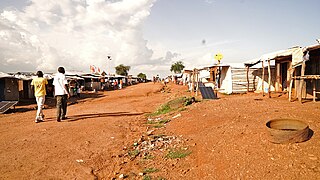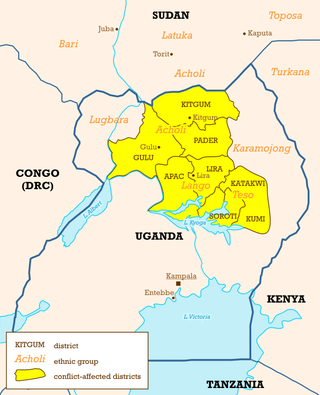Related Research Articles

Jonglei State is a state of South Sudan with Bor as its centre of government and the biggest city. Jonglei state comprises nine counties: Bor, Akobo, Ayod, Uror, Duk, Nyirol, Pigi, Twic East, and Fangak. Jonglei State is the largest state by area before reorganisation, with an area of approximately 122,581 km2, as well as the most populous according to the 2008 census conducted in present-day South Sudan's second period of autonomy. The boundaries of the state were again changed as a result of a peace agreement signed on 22 February 2020.

Juba is the capital and largest city of South Sudan. The city is situated on the White Nile and also serves as the capital of the Central Equatoria State. It is the most recently declared national capital and had a population of 525,953 in 2017. It has an area of 52 km2 (20 sq mi), with the metropolitan area covering 336 km2 (130 sq mi).
Emergency is a humanitarian NGO that provides free medical treatment to the victims of war, poverty, and landmines. It was founded in 1994. Gino Strada, one of the organization's co-founders, served as EMERGENCY's Executive Director. It operates on the premise that access to high-quality healthcare is a fundamental human right.
There are tens of thousands of Sudanese refugees in Egypt, most of them seeking refuge from ongoing military conflicts in their home country of Sudan. Their official status as refugees is highly disputed, and they have been subject to racial discrimination and police violence.
Sudanese Americans are Americans of Sudanese ancestry or Sudanese who have American citizenship. Sudanese Americans may also include children born in the United States to an American parent and a Sudanese parent. Many Sudanese immigrated to the United States in the 1990s as war refugees, escaping from the second civil war. In the 2012 American Community Survey, 48,763 people identified as Sudanese or Sudanese Americans who—or whose ancestors—have emigrated from their native land to the U.S. in the 1980s, 1990s, and 2000s.

Sudan People's Liberation Movement–North, or SPLM–N, is a political party and militant organisation in the Republic of Sudan, based in the states of Blue Nile and South Kordofan. The group's armed forces are formally known as the Sudan People's Liberation Army–North or SPLA–N. As of 2017, its two factions, SPLM-N (Agar) and SPLM-N (al-Hilu) were engaged in fighting each other and against the government of Sudan, and as of 2023, the al-Hilu faction is fighting the Sudanese Armed Forces (SAF), while the leader of the Agar faction was appointed into the military-run government.
Sudanese refugees are persons originating from the country of Sudan, but seeking refuge outside the borders of their native country. In recent history, Sudan has been the stage for prolonged conflicts and civil wars, as well as environmental changes, namely desertification. These forces have resulted not only in violence and famine but also the forced migration of large numbers of the Sudanese population, both inside and outside the country's borders. Given the expansive geographic territory of Sudan, and the regional and ethnic tensions and conflicts, much of the forced migration in Sudan has been internal. Yet, these populations are not immune to similar issues that typically accompany refugeedom, including economic hardship and providing themselves and their families with sustenance and basic needs. With the creation of a South Sudanese state, questions surrounding southern Sudanese IDPs may become questions of South Sudanese refugees.
By January 2011 the United Nations High Commissioner for Refugees (UNHCR) estimated that there are 262,900 Sudanese refugees in Chad. The majority of them left Sudan escaping from the violence of the ongoing Darfur crisis, which began in 2003. UNHCR has given the Sudanese refugees shelter in 12 different camps situated along the Chad–Sudan border. The most pressing issues UNHCR has to deal with in the refugee camps in Chad are related to insecurity in the camps,, malnutrition, access to water, HIV and AIDS, and education.

Ger Duany is a South Sudanese and US-American movie actor and former refugee born in southern Sudan, who was resettled to the United States at the age of 15.
Doro is a village and a refugee camp in Maban County, Upper Nile State, South Sudan. It was previously a part of Upper Nile state.
Greater Maban is a county located in the Upper Nile State of South Sudan. The county capital is the town of Bunj. In 2017, the South Sudan government divided the county into two: North East and South West.
Kiryandongo Refugee Settlement is a refugee camp in Bweyale in Kiryandongo district Uganda.

Eastern Nile was a state in South Sudan that existed between 2 October 2015 and 14 January 2017 when it was divided into Central Upper Nile State and Northern Upper Nile State. It was located in the Greater Upper Nile region and it was part of the former states of Upper Nile and Jonglei. The state bordered the states of Eastern Bieh, Latjoor, Western Bieh, Western Nile, and the country of Ethiopia to the east.
South Sudanese refugees are persons originating from the African country of South Sudan, but seeking refuge outside the borders of their native country. The world's youngest independent country has a recent and troubled history of prolonged conflicts and ecosystem mismanagement such as overlogging, which has led to desertification. These forces have resulted not only in violence and famine, but also the forced migration of large numbers of the population, both inside and outside the country's borders. South Sudan was cited as the largest refugee crisis in 2016, being the world's third largest, followed by Syria and Afghanistan. As of 2022, the UNHCR estimated that there were 2.4 million refugees under its mandate originating from South Sudan, making the country the fifth largest source of refugees.

Bidibidi Refugee Settlement is a refugee camp in the Yumbe District of northwestern Uganda. Home to over 270,000 South Sudanese refugees fleeing the ongoing civil war in early 2017, it was among the largest refugee settlements in the world at the time, and may have been the largest. As of 2018, that distinction was claimed by Kutupalong refugee camp for displaced Rohingya in Bangladesh.

Uganda is one of the largest refugee-hosting nations in the world, with 1,529,904 refugees. The vast influx of refugees is due to several factors in Uganda's neighboring countries, especially war and violence in South Sudan and the Democratic Republic of the Congo, and associated economic crisis and political instability in the region. Uganda has relatively 'friendly' policies that provide rights to the refugees, such as rights to education, work, private property, healthcare and other basic social services.
The Palorinya Refugee Settlement is a refugee camp in the Moyo District of the Northern Region of Uganda. The majority of the population fled the civil crisis in South Sudan in 2016.
This article lists events from the year 2020 in South Sudan

The Maaji refugee settlements are three refugee camps located in Adjumani District in the Northern Region of Uganda, established in 1997. In June 2018, there were 41,764 registered refugees, accounting for 10% of the district's total population. It has primarily admitted refugees from the Second Sudanese Civil War and the ongoing South Sudanese Civil War. The settlements have been attacked several times by the Lord's Resistance Army, along with other camps in the region such as the Baratuku refugee settlement.
References
- 1 2 3 4 5 Cole, Diane (2018-10-17). "'Other Nobel' Goes To Amazingly Humble Surgeon In South Sudan". NPR. Retrieved 2022-08-04.
- 1 2 3 4 5 6 7 8 9 "'Bush doctor' Evan Atar gets top UNHCR 2018 award". The East African. 2020-07-06. Retrieved 2022-08-04.
- 1 2 "South Sudan doctor awarded UN refugee prize". MEO. 2018-09-25. Retrieved 2022-08-04.
- ↑ Welle (www.dw.com), Deutsche. "South Sudanese surgeon awarded prestigious UNHCR refugee prize | DW | 25.09.2018". DW.COM. Retrieved 2022-08-04.